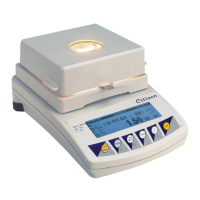
Do you have a question about the Citizen MB Series and is the answer not in the manual?
Describes the MB 200's precision in determining moisture content using halogen heaters for small material samples.
Explains the MB 200's design comprising a balance and drying chamber for stable measurements.
Details the front panel layout, display areas, indicators, and control keypad functions.
Provides instructions for unpacking, identifying contents, stable placement, and proper installation of the moisture analyzer.
Details the automatic heating of the drying chamber and stabilization time after power-on.
Highlights the user menu, work modes, and parameters defined before drying.
Covers preparation for loose, liquid, and solid samples, focusing on sample mass, surface, thickness, and potential additives.
Discusses selecting appropriate drying temperatures and time of testing samples for accurate measurements.
Details automatic drying process, mass comparison, and measurement completion based on user-set time or stable results.
Describes how to set the sample number using the MODE key, ranging from SubSt 1 to SubSt 9.
Explains defining the correction factor for drying temperature, adjustable from SubcoF 0.00 to 0.99.
Details general working modes and specific modes 1-7 for moisture/solids determination based on mass stability or time.
Explains how to set the drying temperature in the range of 50°C to 160°C.
Defines the STROBE INTERVAL time for mass measurement intervals and its effect on test termination.
Describes how to set the precision of displayed results (0.01% or 0.001%) using the dPP option.
Details how to set the drying time, up to 9h 59 min 59s, and its relation to specific work modes.
Details programming parameters, placing sample, starting the weighing process, and observing balance feedback.
Explains independent operation, cooperation with thermal printers (KAFKA 1/Z), and computer connectivity.
Describes cooperation with the KAFKA 1/Z thermal printer, including result printing and final report generation.
Details computer connectivity, conductor schedules, and software for data registration and presentation.
Compares moisture balance speed to traditional methods and highlights the need for parameter selection for optimal results.
Provides tables with suggested optimum parameters (mass, temperature, time) for different types of substances for accurate measurement.
Explains calibration importance for laboratory scale use and the requirement for a class F2 calibration weight.
Focuses on halogen lamp function and indicator stability through specific weight-change tests.
Illustrates and lists optional equipment such as anti-vibration tables, control thermometers, printers, and software.
Presents a table of technical specifications for the MB 200 model, including capacity, readability, temperature, and dimensions.
Provides detailed dimensional drawings and measurements in millimeters for the MB 200 moisture balance.